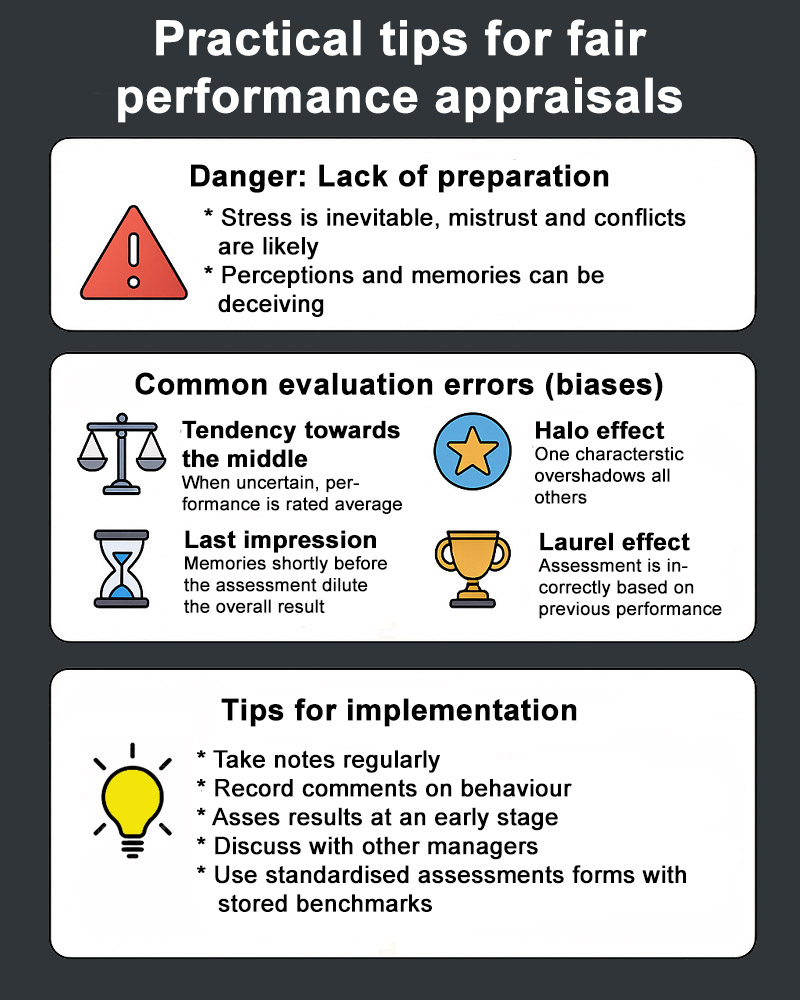The art of performance appraisal
How can you accurately assess employee performance?
For many managers, autumn is a difficult time of year. Regular employee performance appraisals are a requirement in many companies under collective agreements. And based on well-known communication wisdom, I would even go so far as to say that you cannot not assess performance. So there is a valid reason to think about this topic. In this article, I describe three milestones you should achieve to make performance appraisals work.
First, I would like to start with some context. After all, performance can be assessed in various ways. From classic feedback in employee appraisals to target agreements and performance appraisals regulated by collective agreements, everything is possible. In addition, different approaches, characteristics and scales are used in the individual assessment systems. In this article, however, I would like to focus on systems that assess performance using a scale and correspond to a corresponding monetary value. It is precisely such approaches that can become a powder keg of bad moods, because this form of assessment directly affects employees’ wallets.
Clear requirements as the basis for performance appraisal
Let’s start with the basics of performance appraisal and first establish the basic prerequisite for success: it all comes down to the requirements. After all, performance appraisal is not based on your individual standards. Your HR managers may already be pestering you to draw up job descriptions for all positions in your department. These describe what is expected of the people in question.
The first step is therefore to define exactly what is required for these positions:
- What tasks need to be performed in a position?
- What skills must be demonstrated?
- What behaviours are considered successful?
This is a time-consuming and challenging process. Get help from your HR staff, who are experts in this field.
Once you have clearly defined the requirements, you need to communicate them to your employees and clearly formulate your expectations. A common mistake is to skip this step. On the day of the assessment, both employees and managers are then surprised by the scores. This is a recipe for conflict.
One pitfall in the system is the myth that only a perfect score is a good score. In performance appraisals, however, the middle ground is the position that exactly meets expectations. The employee is therefore performing as expected. There is no reason to complain. However, many employees feel that their self-esteem is damaged when they risk being lost in the crowd. You therefore need good, credible and concrete examples and arguments to explain why their performance is no better than the standard. Link these to the requirements to avoid becoming uncertain and having to search for arguments. Ultimately, you make the decisions, with all their consequences. And if performance appraisals are always too good, risks can arise that are borderline for everyone involved. It is not uncommon for good appraisals to be the basis for promotions. And that can be expensive if you make the wrong decision and promote people beyond their abilities.
Year-round preparation and assessment errors
Stress is also inevitable if you only prepare half-heartedly for performance appraisals. We and our brains can deceive ourselves in our perceptions, memories and evaluations. And such deception can have serious consequences. As a manager, you depend on a relationship of trust with your employees.
An assessment based on distortions can lead to mistrust and conflict, as no one can understand how you arrived at your assessment. [1]
One example of an assessment error is the tendency to go for the middle ground. [2] Whenever you are unsure as an assessing manager, you opt for the standard or the middle ground. This is linked to the hope of avoiding trouble.
Another well-known phenomenon is the halo effect, in which one particular characteristic ‘outshines’ other characteristics and conclusions are drawn about overall performance.
An equally popular trap is the last impression effect. Positive or negative memories from the period shortly before the assessment are given too much weight and thus dilute the overall result. But beware: your employees can also consciously exploit these distortions. Are you familiar with the Santa Claus effect? This is the effect that occurs when your employees realise that an assessment is coming up in the next few weeks and they deliberately put in extra effort.
I find the laurel effect particularly amusing. [3] The name says it all: employees rest on their former laurels. Even if their current performance does not meet requirements, their assessment is often simply carried forward. Your employees want an honest assessment. If this is based on distortions and errors, it is a sign of a lack of appreciation that gnaws at the relationship and severely damages your trust.
So prepare conscientiously for the assessment by
- taking notes throughout the year,
- recording comments on behaviour and
- ‘pre-assessing’ results.
The mere fact that you are reading this article can protect you from bias to a certain extent. Awareness is the first step towards omission.
If you are unsure whether your assessment is too biased, you may want to conduct the performance appraisal with another manager and discuss it with them. Standardised assessment forms with defined criteria are also helpful. Use the templates and, as described above, tailor them to the requirements of the position. You can also do this with other managers to ensure consistency across teams and departments. I often see, especially in technical areas, that assessments are discussed between levels and teams and managers have to refute arguments that fall outside their area of responsibility.
Figure: Practical tips for fair performance appraisals
Consistent implementation of performance appraisals
One final characteristic of a good performance appraisal is consistent use of the tool.
In principle, it is right that employees should receive a bonus for exceptional performance. At the same time, however, the appraisal also serves as a pointer and motivator if performance does not meet requirements 100%.
However, for fear of trouble or a yellow card, people tend to err on the side of caution or decide that things aren’t so bad after all. In doing so, managers not only limit their own options, but also demotivate those who perform well. To make matters worse, many collective agreements include a correction factor. This factor compares performance to the company’s profits, for example. Ergo: your performance is only worth as much as the end result. This is as logical as it is frustrating. It is a dilemma that drives many managers to the brink of despair – which is not entirely incomprehensible.
Explaining this approach in a way that is easy to understand requires exceptional communication skills. It also requires a high degree of resilience, because employees who expect to be rewarded for their efforts have a valid point: why should I work harder next year if my performance is not recognised?
Performance appraisal is a tool that should achieve more than just distributing money. It is about providing appreciative feedback between those involved. Possible development steps for the coming years are also discussed. A correction of the assessment and a corresponding reduction in bonus are naturally disappointing and frustrating.
However, this does not relieve managers of their responsibility to identify and evaluate poor performance as such. Performance appraisals also offer opportunities to do this. It is important to remember the principle of normal distribution from time to time. Not all employees can receive the best ratings, as not all of them deliver the best performance in terms of performance appraisals.
In my training sessions, I repeatedly hear the argument that the team is giving 150 per cent. If that is always the case, the requirements are clearly too low. I am not denying that your employees are giving their all. My point, however, is that poorer performance must also be assessed honestly. If you take this step, you will lay the foundation for improvement. Don’t just show your employees that you were not satisfied with certain results, but also how they can do better in the coming year.
This approach requires communication skills to ensure that the feedback is accurate and does not lead to resignation. Explain to the employee specifically what you think is lacking in their performance. What behaviours would you like to see more of/more often in the future in order to be able to give a better assessment?
Conclusion
Fair performance appraisal is a major challenge for managers. At regular intervals, they are required to evaluate performance objectively and comprehensibly in order to rekindle motivation or maintain and increase it.
However, there are many obstacles in the way: unclear expectations that are not communicated openly often form a breeding ground for misunderstandings.
Those who do not prepare adequately or use the performance appraisal tool half-heartedly risk losing valuable trust. Difficult conversations, misunderstandings and emotional setbacks are particularly likely when the appraisal is less than favourable. But remaining silent is not an option.
The art of performance appraisal lies in conducting these conversations with clarity and empathy. Fact-based, comprehensible and respectful. Because you are sitting opposite a person who often bases their self-worth on this assessment. You should therefore approach this process conscientiously: with the courage to be honest, an eye for development potential and the awareness that true leadership does not lie in handing out marks, but in the ability to promote performance.
Notes (partly in German):
Would you like to improve cooperation within your team or your communication skills as a manager? Then visit the website of Michael Zocholl and arrange a consultation. It’s definitely worth it!
[1] Dorsch – Lexikon der Psychologie: Beobachtungsfehler
[2] Personalbeurteilung: Tendenz zur Mitte
[3] ITB Consulting: Beobachtungs- und Bewertungsfehler
Here you will find an article on the question: Is feedback a gift?
And here is an article on Unconscious biases – the world in our heads.
Would you like to discuss this topic as an opinion leader? Then feel free to share this post on social media or within your network.
Michael Zocholl has published two more posts on the t2informatik Blog:

Michael Zocholl
Michael Zocholl is a business psychologist who supports managers and teams in strengthening communication, cooperation and trust in the long term – through workshops, coaching and training. In his podcast Zuhören, Fragen, Führen (Listen, Ask, Lead), he addresses the challenges and opportunities surrounding employee appraisals once a week. Conclusion
In the t2informatik Blog, we publish articles for people in organisations. For these people, we develop and modernise software. Pragmatic. ✔️ Personal. ✔️ Professional. ✔️ Click here to find out more.


